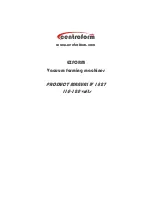
6
| English
Assembly
Preparing the Power Tool
– Control the belt running on the belt sander according to
the operating instructions.
– Switch off the power tool and wait until all moving parts
have come to a complete stop.
Note:
Adjust the sanding belt so that the sanding belt adhes-
ive area is not visible. The power tool cannot be aligned par-
allel in the sanding frame if the adhesive area is sitting on the
workpiece during alignment.
Assembly steps (see figure A)
– Do not adjust the thumbwheel
(4)
whilst the power tool is
removed.
❶
Place the power tool with the groove
(3)
onto the ec-
centric bolt
(7)
from the side.
❷
Then place the groove on the opposite side onto the ec-
centric bolt
(6)
.
❸
Push the nose of the power tool fully into the retaining
spring
(5)
. If correctly fitted, the two claws next to the
nose will sit in the two bars next to the retaining clip
(5)
.
– Place the sanding frame with the power tool fitted on a
level surface and loosen the screws
(9)
,
(10)
.
– Push the power tool down until it is level with the flat sur-
face and firmly tighten the screws
(9)
,
(10)
in this posi-
tion.
– Turn the thumbwheel
(4)
to adjust the material removal
rate:
Higher = turn the thumbwheel
(4)
clockwise (+).
Lower = Turn the thumbwheel
(4)
anticlockwise (−).
Changing the Sanding Belt
First pull the power tool up and out of the spring
(5)
. Then
pull the power tool out of the eccentric bolt
(6)
and
(7)
.
You do not need to realign the power tool in the sanding
frame after reinserting it.
Do Not Adjust if Material Removal is Uneven
Loosen the screw
(10)
slightly on the side with too much
material removal. Then turn the screw
(8)
slightly anticlock-
wise (this raises the power tool) and retighten the
screw
(10)
.
Working Advice
The material removal rate and the sanding finish are determ-
ined by the position of the thumbwheel
(4)
and by the sand-
ing belt grain.
The brush insert
(1)
is recommended for more delicate
workpieces and improves dust extraction.
The plastic insert
(2)
is recommended for precise surface
grinding, particularly along workpiece edges.
Place the sanding frame with the power tool fitted onto the
workpiece you want to machine and switch on the power
tool.
Work with as little sanding pressure as possible. The power
tool’s own weight is sufficient for a good sanding perform-
ance. This protects the sanding belt, produces a smoother
workpiece and reduces energy consumption.
Work with moderate feed, parallel and with overlapping
strokes. Sand with the grain; sanding marks that run against
the grain result in bothersome sanding effects.
Do not switch the power tool off until it has been lifted off
the workpiece. Always wait until the power tool has come to
a complete stop before placing it down.
Maintenance and Service
After-Sales Service and Application Service
Our after-sales service responds to your questions concern-
ing maintenance and repair of your product as well as spare
parts. You can find explosion drawings and information on
spare parts at:
www.bosch-pt.com
The Bosch product use advice team will be happy to help you
with any questions about our products and their accessor-
ies.
In all correspondence and spare parts orders, please always
include the 10‑digit article number given on the nameplate
of the product.
Australia, New Zealand and Pacific Islands
Robert Bosch Australia Pty. Ltd.
Power Tools
Locked Bag 66
Clayton South VIC 3169
Customer Contact Center
Inside Australia:
Phone: (01300) 307044
Fax: (01300) 307045
Inside New Zealand:
Phone: (0800) 543353
Fax: (0800) 428570
Outside AU and NZ:
Phone: +61 3 95415555
www.bosch-pt.com.au
www.bosch-pt.co.nz
Great Britain
Robert Bosch Ltd. (B.S.C.)
P.O. Box 98
Broadwater Park
North Orbital Road
Denham Uxbridge
UB 9 5HJ
At www.bosch-pt.co.uk you can order spare parts or arrange
the collection of a product in need of servicing or repair.
Tel. Service: (0344) 7360109
E-Mail: [email protected]
1 609 92A 5MC | (02.03.2020)
Bosch Power Tools







































